Apartments, apartments, and more apartments
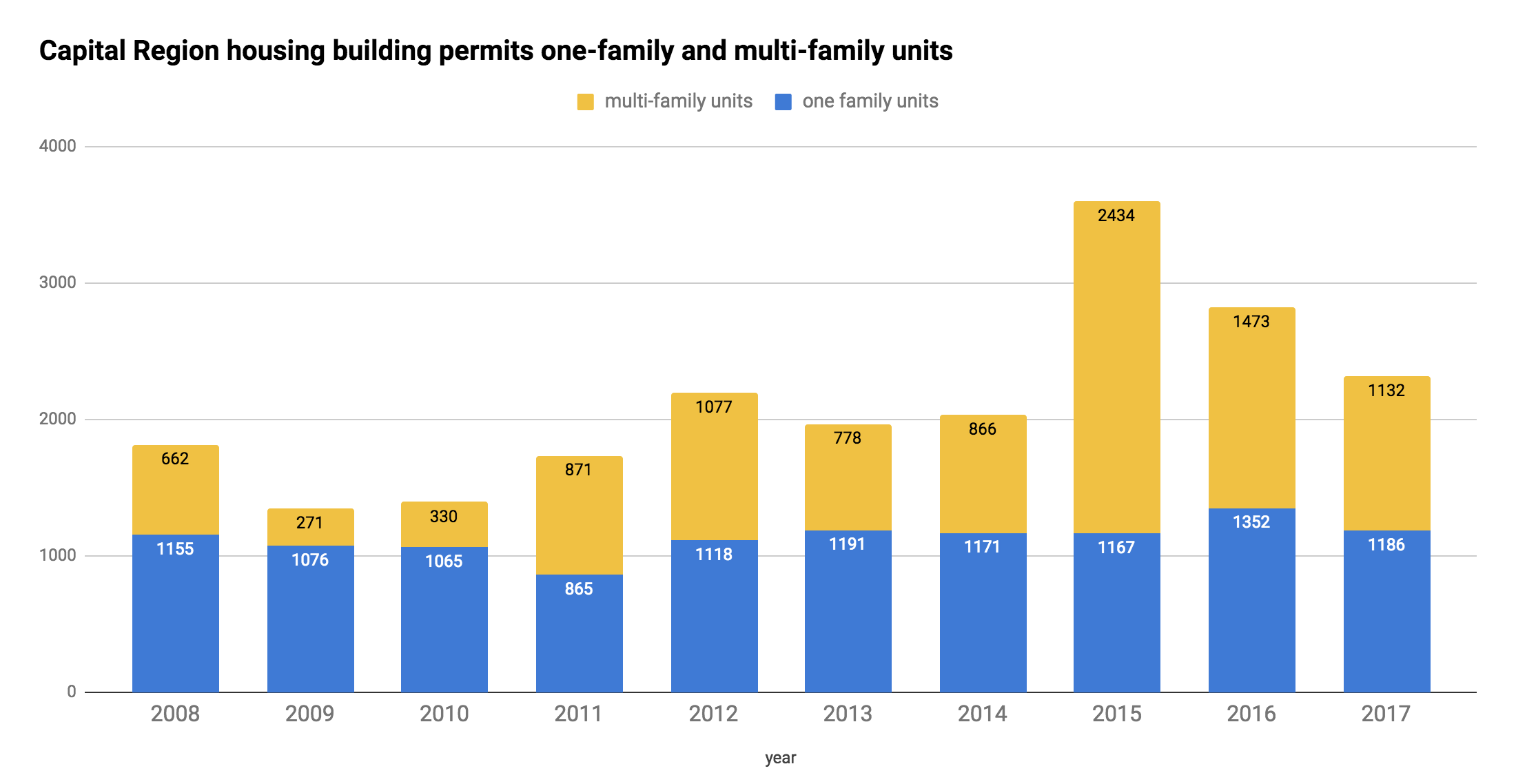
Capital Region building permits for residential units over the last decade -- for single family homes and units in multi-family buildings.
Sometimes during episodes of Exciting Tales of the Albany Planning Board and related whatnot, we refer to the apartment building boomlet that's been going in Albany and around the Capital Region.
Right, so about the specifics of that boomlet... The Census Bureau collects data on the number of building permits for housing units issued each year in each municipality. And those numbers help draw the outline of this trend.
For example: The chart above shows the number of overall units covered by building permits issued for the four core Capital Region counties over the last decade -- along with how many of those units were in multi-family buildings (yellow). And as you can see, there's been an upswing in multi-family units in that time, especially the last few years.
More context? More details? OK, let's have a look...
The numbers
These numbers are collected and published by the Census Bureau, where you can download them. But the Capital District Regional Planning Commission also does that and makes them easier to view in a bunch of sortable tables and charts.
We've scooped up numbers from the Census and CDRPC.
More charts
There are a few more charts at the top large format -- click or scroll all the way up.
A few things
Apartments vs. single-family homes
One of the things that jumps out in looking at the split between single-family units and multi-family units since 1980 is the relatively small number of new single-family homes built during the 2010s compared to the previous decades.
That's helped shift the overall mix of new units toward multi-family. In fact, there were more multi-family units permitted in 2015 and 2016 than single-family units, which hadn't happened going back as far as 1980. In 2017 single-family edged ahead again, but only with 51 percent of the overall units.
Saratoga and Albany counties... but mostly Saratoga
Municipalities in Saratoga and Albany counties have both issued the most number of building permits for housing units -- by far -- going back to 1980. That's been especially true in the 2010s -- thanks mostly to Saratoga County.
But Schenectady County has been picking things up a bit the last three years, adding a bunch of multi-family units in Schenectady (395), Rotterdam (269), Niskayuna (187).
Top 5
The top 5 municipalities for building permit housing units since 2007 (single / multi):
1. Halfmoon: 2,466 (1,571 / 895)
2. Colonie: 2,079 (1,253 / 826)
3. Saratoga Springs: 1,574 (520 / 1,054)
4. Bethlehem: 1,205 (558 / 647)
5. Wilton: 1,193 (498 / 695)
CDRPC has a few good graphs related to the top 10.
Of course, Halfmoon has been the fastest growing municipality by percentage locally the last few years, and was tops in the state last year. [TU]
It's also notable that even though the top 5 include lots of suburban areas, the municipalities have been adding significant amounts of multi-family units, which is maybe a little surprising (except in the case of Saratoga Springs).
City of Albany
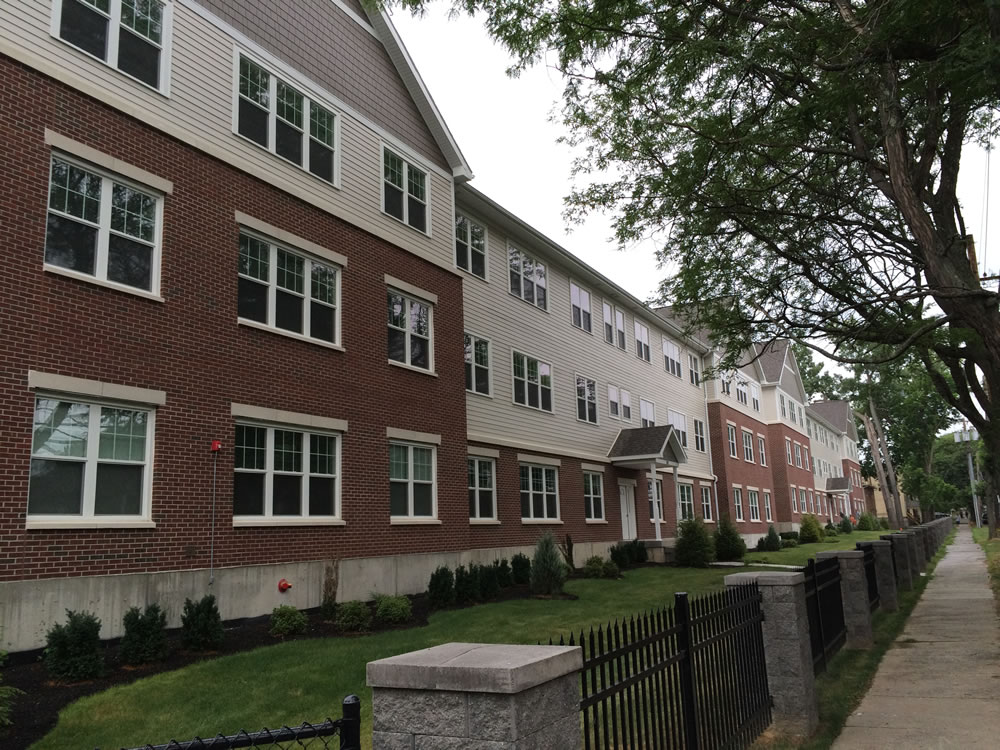
The Elefteria on South Allen, one of a handful of new or planned apartment buildings in the city Albany during the past few years.
The city of Albany just missed out on being in that since-2007 top 5 -- it was #6 with 1,135 units, 902 of them multi-family. And it ranked #2 overall for most number of multi-family units added, behind only Saratoga Springs.
It's interesting that Albany has added more than 1,000 new residential units over the last decade, yet the Census Bureau estimates that the city's population is relatively flat since 2010 and has even been declining since 2013.
A possible piece of that puzzle: The most recent Census Bureau American Community Survey 5-year estimates (for 2016) have the number of overall housing units in the city relatively flat since 2010. (The number bobs around a bit, but the margin of error is relatively large.) Though the number of overall rental units does appear to be ticking up the last few years. (Again it's hard to say for sure given the margin of error.)
But that same set of Census Bureau data also points to rising rents -- the estimated median gross rent paid in the city has risen each year, from 816 in 2010 to 875 in 2016. And the estimated number of renters paying more than $1,500 a month rose from approximately 3.6 percent of renters in 2010 (estimated 881 renters) to approximately 5.8 percent in 2016 (estimated 1,493 renters). The number of households paying 35 percent or more of household income in gross rent hovered around the 45 percent mark during that time.
There are hundreds of more units -- either approved or proposed, both new construction and redeveloped -- in the pipeline for the city over the next year or two. And there appears to be plenty of demand for these new units. (Developers say they fill quickly.) So we're very curious to see how things shake out in the 2020 Census -- and what sort of effect (if any) the new apartments have on rents along the whole spectrum.
Earlier
Say Something!
We'd really like you to take part in the conversation here at All Over Albany. But we do have a few rules here. Don't worry, they're easy. The first: be kind. The second: treat everyone else with the same respect you'd like to see in return. Cool? Great, post away. Comments are moderated so it might take a little while for your comment to show up. Thanks for being patient.
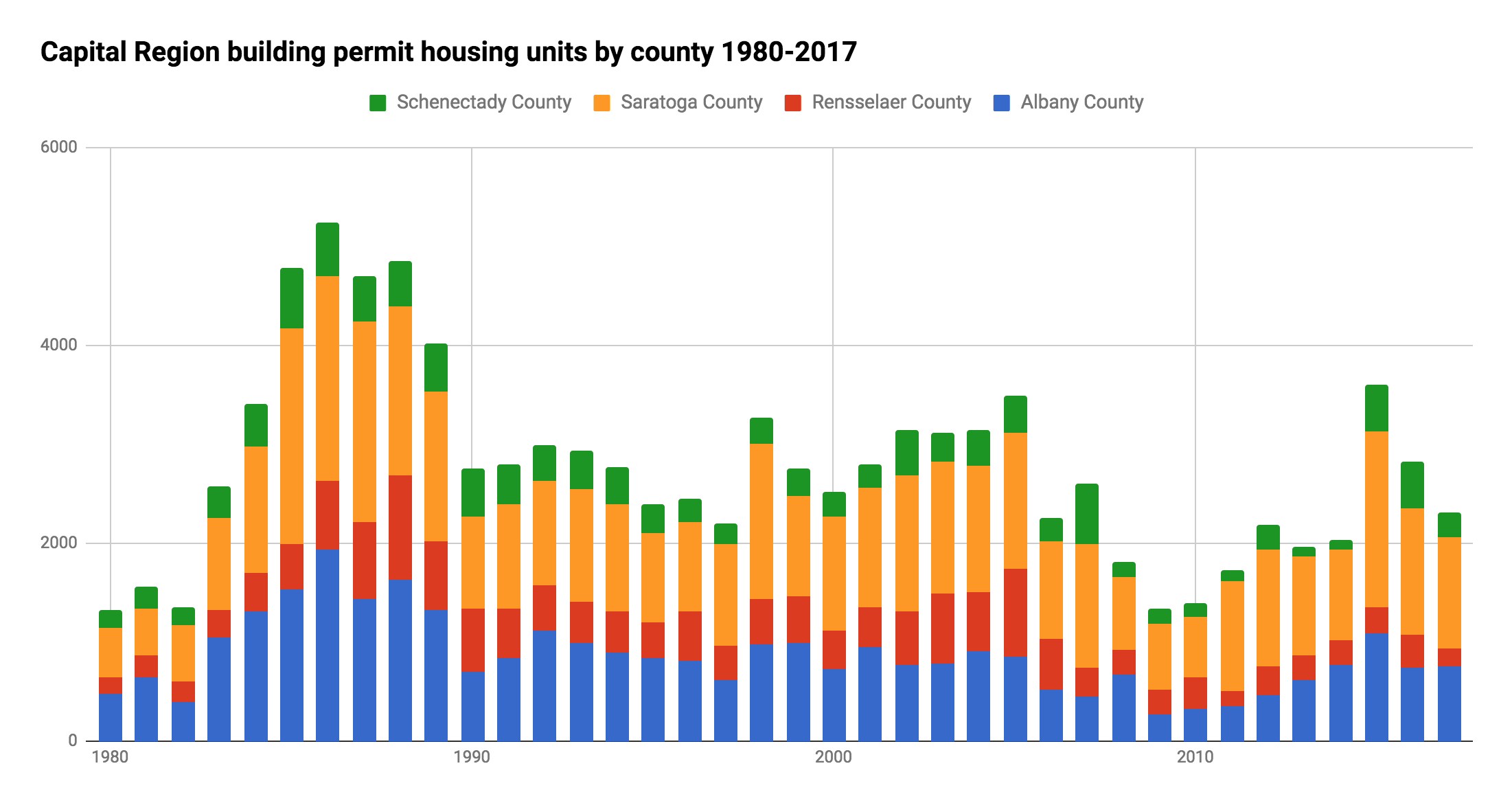
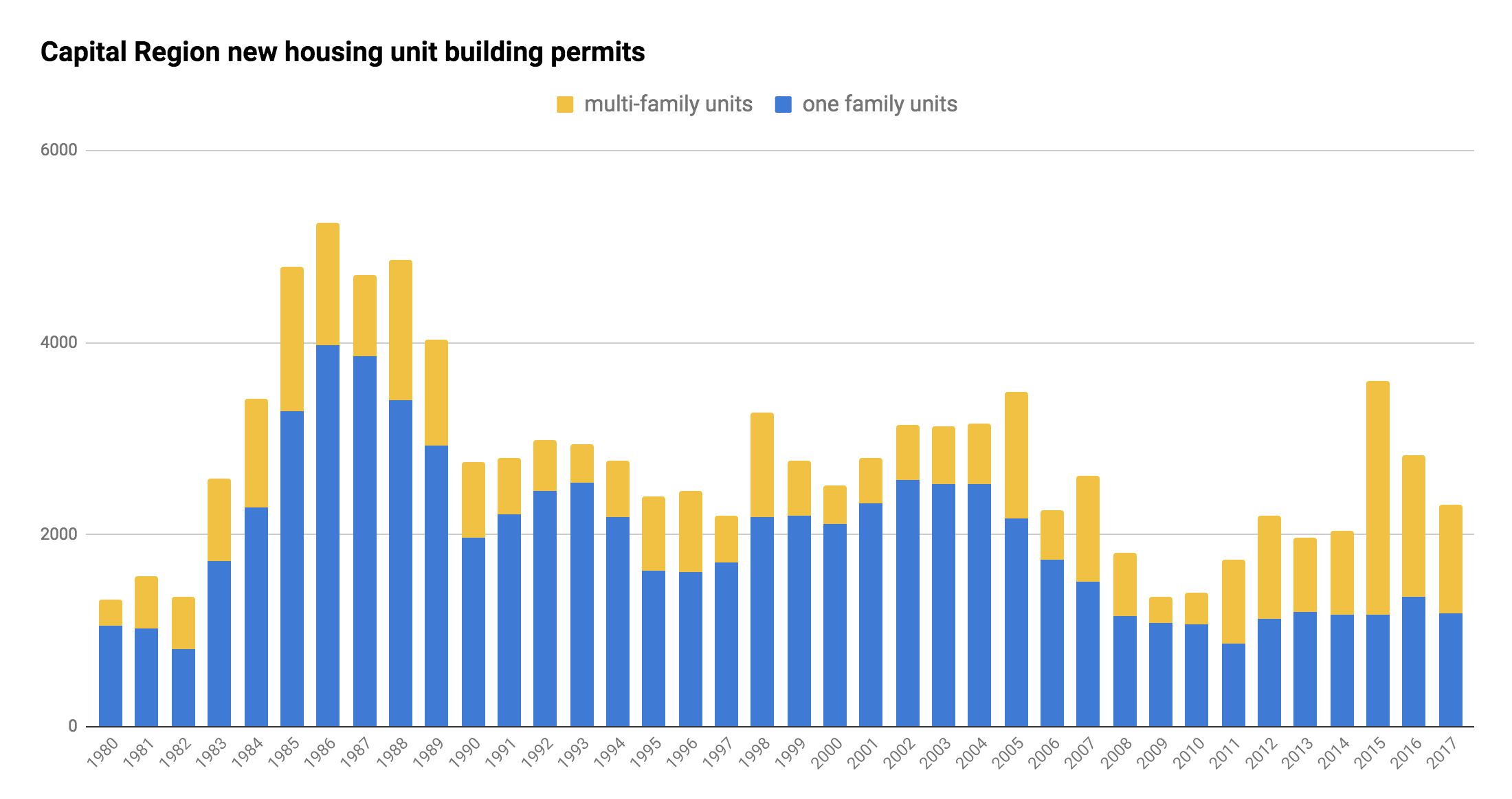
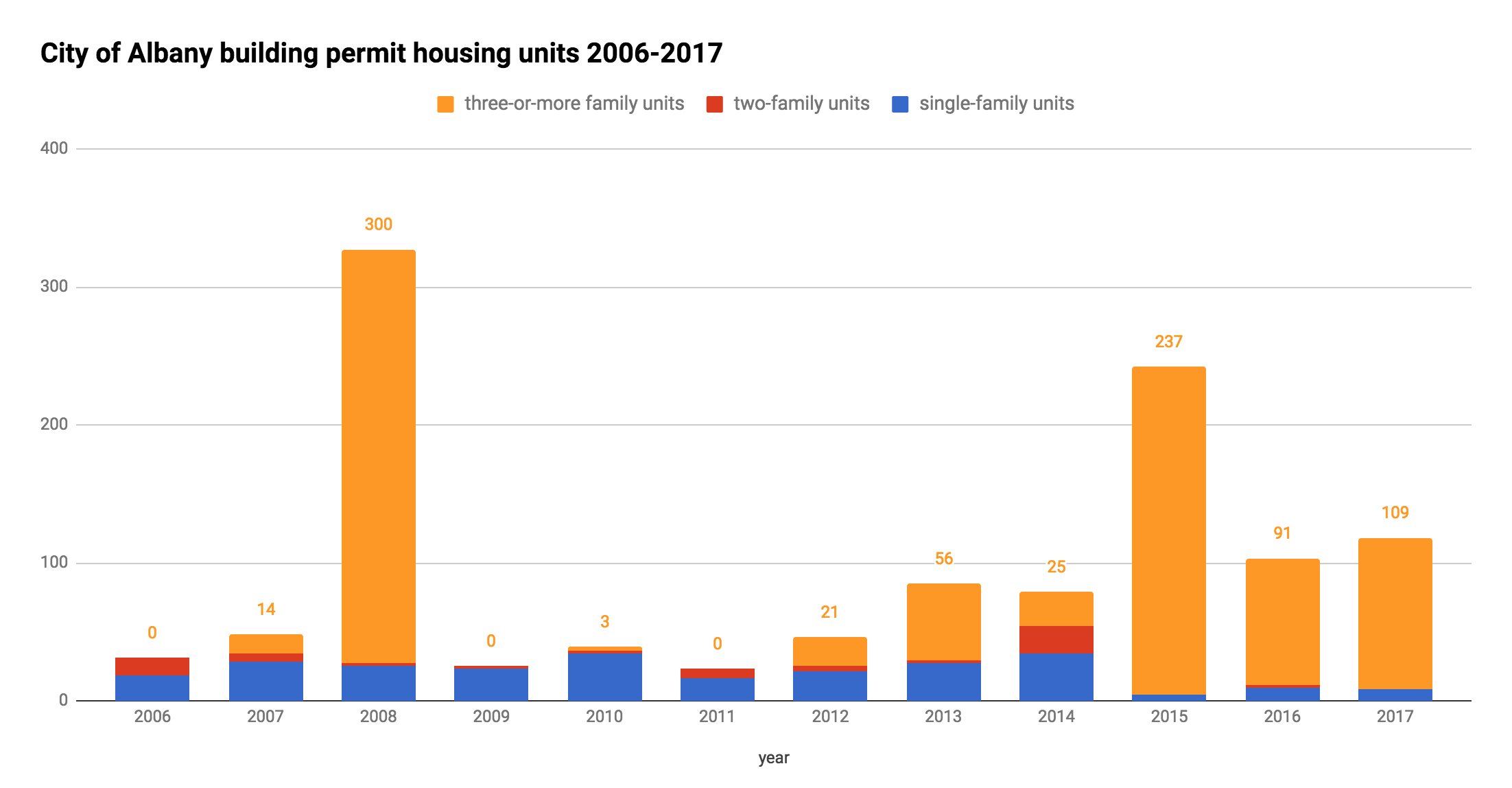
Comments
The city of Albany's overall population level being flat could be the result of the loss of a ton of housing units in West Hill and in the South End. Albany has added these new units that were discussed in the article, but it's also lost a lot of old units. Families also keep getting smaller, so there's fewer people in each unit. Or, the population estimates just could be off.
... said PK on Jun 1, 2018 at 2:52 PM | link
" Families also keep getting smaller, so there's fewer people in each unit."
That's what immediately came to mind to me. The 1980s and early 90s were the each-of-the-baby-boom generation, so there are a lot of mid-20s to mid-30s folks moving to their own place. Especially when a lot of them delayed moving out of home for a few years due to the Great Recession.
... said Daniel on Jun 1, 2018 at 3:11 PM | link
A small whine: I wish some part of the "apartment boomlet" included (non luxury) condos...such as the buildings at the Playdium site--surely one or two the buildings could be constructed for condo ownership with the majority of the other buildings being apartments. IMO condos would attract a different market segment which could help keep the complexes stable with long term condo owners to balance out higher turnover apartment tenants, etc. Just a thought.
... said jsc on Jun 1, 2018 at 3:34 PM | link
I'm with jsc - I wish more condo development in the capital region was in the cities and not just in the burbs. I live in one of the few Albany condos right now but it would be nice to have other options.
... said Paul on Jun 1, 2018 at 4:42 PM | link
Interestingly despite the excess of apartments the prices are not dropping. Some complexes in southern Saratoga have high vacancy rates but they still charge like $1500 for 1 bedroom.
... said Lu on Jun 2, 2018 at 12:15 AM | link
The reason condos are not being built is that construction financing for condo projects is much more difficult than apartment projects. It's easier to build them as apartments and do a conversion down the line if wanted.
... said BethAM on Jun 4, 2018 at 11:21 AM | link
Also agreed about condos. I'm lucky enough that my mortgage is cheaper than rent but maintaining an entire house and yard is getting old. I'd never move and waste money on rent that's higher than my mortgage, but the thought of owning a cool space downtown (or some other build site that's not in the burbs and not a generic condo development) with a washer/dryer and one parking place for under, let's say, $200,000? A girl can dream.
... said Rebecca on Jun 4, 2018 at 12:02 PM | link
To those looking for condo development v. apartments. The financing and approval of condo units is different from apartments. Condos also require a stronger real estate market than apartments.
... said Erin on Jun 4, 2018 at 12:09 PM | link
My wife is always wondering why 3-family historic homes in Albany seem to never be converted into condos. Is there any legal hurdle to it?
... said Lex on Jun 4, 2018 at 12:22 PM | link
Condos are really hard to make work for a number of reasons, but primarily in a market like the Capital Region's, its a financial issue. Also there are tons of rules that make it more onerous, and nobody will go through that long and expensive process just for fun without a significant payback. Even the condo market in NYC has gone down significantly.
If you want to build your own condo here are the rules:
https://ag.ny.gov/sites/default/files/pdfs/bureaus/real_estate_finance/escrow/13%20NYCRR%20%C2%A7%2023.3.pdf
Part 16 of Title 13 NYCRR
Regulations governing Real Estate Syndication Offerings
Part 18 of Title 13 NYCRR
Regulations Governing the Conversion of Occupied Residential Property to Cooperative Ownership
Part 20 of Title 13 NYCRR
Regulations Governing Newly Constructed, Vacant or Non-Residential Condominiums
Part 21 of Title 13 NYCRR
Regulations Governing Newly Constructed and Vacant Cooperatives
Part 22 of Title 13 NYCRR
Regulations Governing Newly Constructed, Vacant Homeowners Associations or Non-Residential Property Owners Associations
Part 23 of Title 13 NYCRR
Regulations Governing the Conversion of Occupied Residential Property to Condominium Ownership
Part 24 of Title 13 NYCRR
Regulations Governing Timeshare Offering Plans
Part 25 of Title 13 NYCRR
Regulations Governing Newly Constructed or Vacant Senior Residential Communities
Part 80 Intrastate Financing
Regulations Governing Intrastate Financing of Non-Real Estate Securities
... said Emily on Jun 4, 2018 at 3:36 PM | link
Regarding Emily's comprehensive list and associated comments:
ELI5 (explain like I'm 5) why condos are so expensive/onerous for developers to consider? Are regulations a holdover from a different time? Or is there some apartment building construction lobby at play here? I'm genuinely curious since a ownership without the hassle of a house seems desirable to younger and older people...
... said Rebecca on Jun 4, 2018 at 7:16 PM | link
So with all that being said - with the real estate market and housing prices in an upswing, and interest in living downtown also on the rise, you'd think that this would be the perfect time for some of these developments to be made as condos, even if it means jumping through more legal hoops.
Rebecca - a unit in 409 Madison just went up for sale, check it out :)
... said Paul on Jun 5, 2018 at 10:51 AM | link